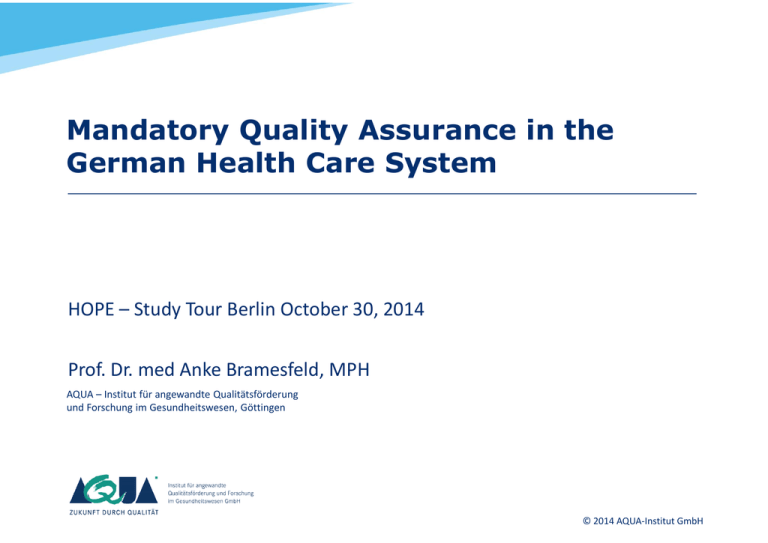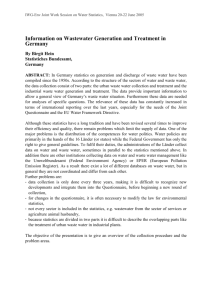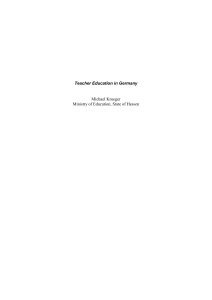Mandatory Quality Assurance in the German Health Care System
advertisement

Mandatory Quality Assurance in the German Health Care System HOPE – Study Tour Berlin October 30, 2014 Prof. Dr. med Anke Bramesfeld, MPH AQUA – Institut für angewandte Qualitätsförderung und Forschung im Gesundheitswesen, Göttingen © 2014 AQUA-Institut GmbH 1 Göttingen Established in Göttingen, Germany in 1995 Independent, impartial, focused on quality measurement and improvement in health care © 2014 AQUA-Institut GmbH 2 Business areas Quality in health care Quality improvement and accreditation programs with indicators and benchmarking (Germany, Austria, Switzerland, Algeria, Kenya, Tanzania, etc.) Development and implementation of data-based programs for improvement of chronic care, multi-morbidity and rational prescribing (Germany) Institute that executes mandatory national quality assurance for health services according to §137a of the German Social Code, Book V: © 2014 AQUA-Institut GmbH 3 Agenda § § § § § § Background of Quality Assurance (QA) Technical functioning of QA Example: QA breast surgery Methodology to develop QA procedures New Developments Summing up © 2014 AQUA-Institut GmbH 4 Background: The German health care system § § § § § Population 80.5 Mill 16 „Länder“: different infrastructure, same regulations for medical services (insurance coverage) (German Social Code, Book Five) Health insurance: 88 % statutorily health insured (132 insurance companies), 11.8 % privately insured, 0.2 % not insured: - SHI-represented by National Association of SHI Funds 1,700 Hospitals - represented by German Hospital Federation Outpatient care: dominated by office-based physicians: 144,000 physicians - represented by National Association of SHI Physicians and of Dentists Data 2012, Stat. Bundesamt © 2014 AQUA-Institut GmbH 5 Policy & Administrative Framework Federal Ministry of Health Supervision and control of legality § § § Federal Joint Committee (G-BA) decides on Clinical Areas approves indicators enacts regulations National Association of SHI Physicians National Association of SHI Funds German Hospital Federation (Patient Representatives) Commission AQUA Institute § § § § develops and proposes indicators implements QA collects data reports data annually © 2014 AQUA-Institut GmbH 6 History § 2004: • DRG-Reimbursement for all medical procedures (except mental health care) • Mandatory QA for certain procedures (clinical areas) in hospital o To control for unwanted effects of DRG o QA is carried out by an institution on ad hoc commission, belonging to the carriers of health care § 2009: • QA is commissioned to independent institution (AQUA Institute) after tender • Political decision to expand QA cross-sectorally § 2014: • Status of QA: » 30 clinical areas (all hospital) » 400+ indicators o 20% indicators risk-adjusted o 289 publically reported » 9 clinical areas for cross-sectoral QA developed/in development § 2016 • QA will be executed by a public institute: Institut für Qualität und Transparenz im Gesundheitswesen (IQTIG) © 2014 AQUA-Institut GmbH 7 Concept and Aim of QA § Concept • Patient-centered, patient outcome » Patients involved in all processes of QA • Focus on quality deficits in service pathways § Aim • • • • Compare similar services of different providers Quality improvement (learning approach) Accountability of service provider Transparency & patient information © 2014 AQUA-Institut GmbH 8 Scope of QA § § § § § § Measure quality with indicators QA only for clinical areas (no general indicators) 30 clinical areas (all hospital) 434 indicators (78 risk adjusted) Annual assessment and feedback At the moment: - Only hospitals Data collection mainly via extra documentation © 2014 AQUA-Institut GmbH 9 Agenda § § § § § § Background of Quality Assurance (QA) Technical functioning of QA Example: QA breast surgery Methodology to develop QA procedures New Developments Summing up © 2014 AQUA-Institut GmbH 10 Infrastructure for supporting QA: 1 AQUA + 17 Länder Administrative Offices for Quality Assurance Länder Office Länder Office Länder Office Länder Office Länder Office Länder Office Länder Office AQUA, data handling, analysis and processing of data Länder Office Länder Office Länder Office Länder Office Länder Office Länder Office Länder Office Länder Office Länder Office Federal/ Länder Expert Groups Länder Office © 2014 AQUA-Institut GmbH 11 Flow of Data 17 Länder Administrative Offices for Quality Assurances 1. Data Collection 2. Data Processing + Analysis QA Data Outcome Report 3. Reporting Federal/Länder Expert Groups © 2014 AQUA-Institut GmbH 12 1. Data Collection § At present: • Majority of data recorded manually (but not paper-based) • Follow-up: in-hospital or voluntary reporting • Increasingly data taken out of Electronic Hospital Reporting System § Future: • Health insurance claims data (also crosssectionally) • Patient survey (difficult to be implemented) § Some documentation by hand is un-avoidable © 2014 AQUA-Institut GmbH 13 ØDirect QA procedures ØIndirect QA procedures © 2014 AQUA-Institut GmbH 14 2. Data Processing + Analysis Sending to hospitals, -6 months Collecting Data Commenting Results Approval by G-BA Reviewing + adjusting indicators, -11 months (Jan–Dec) (Nov–Dec) Response service provider (Structured Dialogue) (June–Oct) Analysis of Data (March–June) Feedback to service providers (June 15th) © 2014 AQUA-Institut GmbH 15 Structured Dialogue: work flow • Last data in - feedback to hospitals: 6 months • Last data in - conclusion of Structured Dialogue: 9 months • Last data in - report to G-BA: 17 months © 2014 AQUA-Institut GmbH 16 Structured Dialogue – participants and responsibilities Direct procedure Indirect procedure 17 Steering Committee The G-BA’s Subcommittee for Quality Assurance AQUA Institute (regional hospital association) Federal Experts’ Working Groups 17 Länder Offices 17 Experts’ working groups and task forces Länder Office Länder Office Länder Office Länder Office Länder Office Länder Office Structured Dialogue Länder Office Länder Office Länder Office AQUA, data handling, analysis and processing of data Länder Office Länder Office Länder Office Länder Office Länder Office Länder Office Länder Office Länder Office Healthcare providers © 2014 AQUA-Institut GmbH 17 Structured Dialogue: Measures taken and results, Data 2012 Statistical Discrepancies 19,440 No measures 1,000 (5%) Notice sent 8,500 (44%) Statement requested 9,800 (50%) Other 140 (0,7%) Meeting 290 On-site inspection 63 Target agreement 453 Qualitatively non-discrepant 37% Qualitatively non-discrepant with special monitoring 51% Qualitatively discrepant 11% © 2014 AQUA-Institut GmbH 18 Measures taken for computational discrepancy according to Land (+AQUA) Notification Response demanded No measures Other 100% 90% 80% 70% 60% 50% 40% 30% 20% 10% 0% 2012 2011 2012 2011 2012 2011 2012 2011 2012 2011 2012 2011 2012 2011 2012 2011 2012 2011 2012 2011 2012 2011 2012 2011 2012 2011 2012 2011 2012 2011 2012 2011 2012 2011 Bavaria Brandenburg Berlin BadenWürttemb. Bremen Hesse Hamburg Mecklenb.Pomm LowerSaxony North Rhineland- Schleswig- Saarland Rhine-West. Palatinate Holstein Saxony Saxony Anhalt Thuringia AQUA Institut © 2014 AQUA-Institut GmbH 19 3. Reporting Annually: 1. Hospital-specific data published on health insurance websites 2. German Hospital Quality Report, free download of 2009–2012 reports in English, http://www.sqg.de/qualityreport/index.html 3. Report: Analysis of Länder Results 4. Report on Structured Dialogue Hospital mortality, community-acquired pneumonia, data 2012 © 2014 AQUA-Institut GmbH 20 Agenda § § § § § § Background of Quality Assurance (QA) Technical functioning of QA Example: QA breast surgery Methodology to develop QA procedures New Developments Summing up © 2014 AQUA-Institut GmbH 21 Indicators breast surgery 2013: 62,766 cases of breast-cancer surgery in 745 hospitals Reference range Result Result 2013 2012 Trend ≥ 90,0 % 96,1 % 95,9 % = ≥ 95,0 % 96,7 % 97,1 % = Not defined 66,7 % 63,5 % + ≤ 5,0 % 1,1 % = ≤ 29,8 % 16,0 % 18,1 % + ≥ 80,0 % 93,9 % 87,7 % + Time: diagnosis 7. Less than 7 days between diagnosis and surgery ≤ 42,1 % - surgery 8. More than 21 days between diagnosis and surgery ≤ 55,1 % 10,5 % 12,3 % + 27,0 % 23,8 % - Subject Indicator Pre-therapeutic 1. Pre-therapeutic diagnosis histologically verified diagnostics Intra-operative 2. Intra-operative specimen x-ray with diagnostics mammographic wire marking 3. Intra-operative specimen sonography with sonographic wire marking 4. Primary axillary dissection in DCIS 5. Lymph node removal with DCIS and breast conserving therapy 6. Sentinel lymph node biopsy Data: Federal report 2013, Breast Surgery 1,7 % © 2014 AQUA-Institut GmbH 22 2013 results for indicator More than 21 days between diagnosis and surgery Time Diagnosis- Surgery 2013: Median 15 days Hospitals > 20 cases, n= 514 Median: 22 % (range 0-79%) Hospitals < 20 cases, n= 231 Median: 13 % (range 0-100%) Data: Federal report 2013, Breast Surgery © 2014 AQUA-Institut GmbH 23 Structured Dialogue: Results breast surgery 2012 Indicator Computational Discrepancies n/% Ind. 7+8: time diagnosis surgery 131 Qualitatively non-non discrepant n/% 126/86.2% Qualitatively discrepant Dokumentatio n Problem n/% n/% 2/1.5% 1/0.8% Data: Report on Structured Dialogue 2012 No collaboration n/% 0/0.0% © 2014 AQUA-Institut GmbH 24 Agenda § § § § § § Background of Quality Assurance (QA) Technical functioning of QA Example: QA breast surgery Methodology to develop QA procedures What is new in mandatory QA? Summing up © 2014 AQUA-Institut GmbH 25 Process of developing QA procedures Approved by Concept 1. Identifying indicators 2. Panel Test phase Implemen -tation 3. Feasibility check © 2014 AQUA-Institut GmbH 26 1. Identifying indicators • Indicators only to be developed for quality deficits Identify quality deficits in health service chain Search for existing indicators Match existing indicators to deficits Develop new indicators were necessary Panel © 2014 AQUA-Institut GmbH 27 2. Panel § Multidisciplinary Panel All possible indicators Panel Comprehensibility Relevance Feasibility Final set of indicators © 2014 AQUA-Institut GmbH 28 3. Feasibility check Final set of indicators health insurance data Data specification Documentation hospital Questionnaire, data specification Documentation outpatient service, Questionnaire, data specification Not possible to assess Propose how indicator could be assessed Drop it © 2014 AQUA-Institut GmbH 29 Agenda § § § § § § Background of Quality Assurance (QA) Technical functioning of QA Example: QA breast surgery Methodology to develop QA procedures What is new in mandatory QA? Summing up © 2014 AQUA-Institut GmbH 30 Developments: cross-sectional quality assurance § Rational outpatient hospital day-clinic outpatient rehab • Longer follow-up • Similar procedures in in- and outpatient care (e.g. cataract surgery) • Disorders predominately cared for in outpatient care (mental disorder, renal failure) § Precondition • No data transfer between in- and outpatient care • Different coding systems in in- and outpatient care § Challenge • Triggering cases for documentation • Follow-up of patients • Documentation in outpatient care © 2014 AQUA-Institut GmbH 31 Developments: Data Sources § Use of health insurance claims data • Only data that is available cross-sectorally • Law allowing use of claims data in place since 2012, directives to be expected 2014 § Patient questionnaire • To supplement indicators, case-related • Mode of distributing the questionnaire still unclear • Patient questionnaires in development for Arthroscopy 1. Reduce documentation efforts for service and PCI § Peer Reviews providers 2. Gain new information © 2014 AQUA-Institut GmbH 32 Developments: Comparative public reporting © 2014 AQUA-Institut GmbH 33 Agenda § § § § § § Background of Quality Assurance (QA) Technical functioning of QA Example: QA breast surgery Methodology to develop QA procedures What is new in mandatory QA? Summing up © 2014 AQUA-Institut GmbH 34 Summing up § § § § § 10 years mandatory QA in Germany Gotten more complex Firm implementation in health care system Continuous rise in relevance Future: - use more health insurance data Include outpatient services Patient questionnaire Public reporting QA can point to problems in health care. It can not solve these problems © 2014 AQUA-Institut GmbH 35 Please visit our website www.sqg.de © 2014 AQUA-Institut GmbH 36 Thank you for your kind attention! AQUA – Institute for Applied Quality Improvement and Research in Health Care GmbH Maschmühlenweg 8–10 37073 Göttingen Phone: (+49) 551 / 789 52-0 Fax: (+49) 551 / 789 52-10 office@aqua-institut.de www.aqua-institut.de www.sqg.de © 2014 AQUA-Institut GmbH 37



